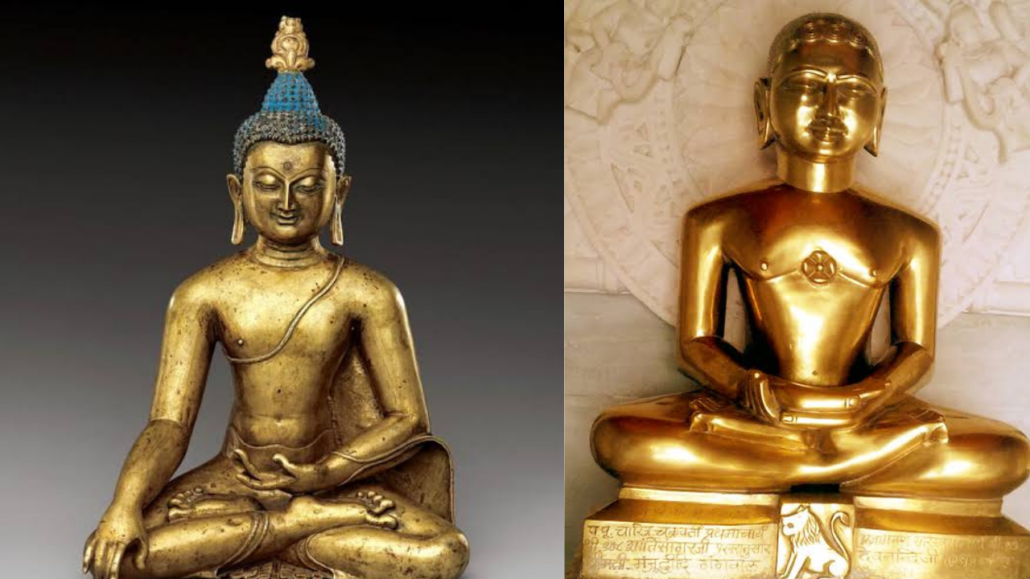During the second half of the sixth century BC, there were almost 62 religious sects based on regional customs and rituals. While the varna system was dominating in various parts of India, two sects named Buddhism and Jainism started influencing the common people of the country. Though the origin of Jainism goes back to very ancient times, the actual spread of Jainism started with Vardhamana Mahavira. Gautama Siddhartha or Buddha, a contemporary of Mahavira, started Buddhism to help people attain nirvana.
Though Jainism was established way before Buddhism, Buddhism covered many places compared to Jainism. Both Mahavira and Buddha belong to noble families (Kshatriyas) and both of them renounced their status, pleasures and comforts and left their royal palaces at the age of 30 and 29, respectively.
Cause For Spread of Buddhism
Ideological Differences:
Unlike Buddhism, Jainism did not condemn the varna system which degraded the people belonging to lower varna. Mahavira believed that a person is born in higher or lower varna is the consequence of his /her sins gained in the previous birth. Buddha allowed everyone, irrespective of caste or sex, to attain salvation. Whereas Mahavira saw women as incapable of attaining salvation unless they were first reborn in male form.
Buddhism was liberal and democratic than Brahmanism, though it took most of its principles from Hinduism and Jainism. The teachings of Jainism (Kaivalya- reincarnation of soul) were not well received by people due to lack of belief. Whereas the ideology of Buddha- Nirvana (end of suffering, unsatisfactoriness) was well received by common people and rulers.
Jainism followed extreme non-violence that it prohibited the practice of agriculture and taboo if travelled by water, as it harmed organisms more compared to barefoot land travel.
Royal Patronage:
Buddhism was embraced by various kings who helped in its spread by sending missionaries to various countries. Ashoka was an important turning point for Buddhism as he propagated Buddha dhamma after the Kalinga war and asked his subjects to follow the same. He even sent missionaries to Sri Lanka, Tibet, Burma and parts of China and Japan to propagate Buddhism. Greeks and Kushans who ruled north western India embraced Buddhism and popularised in different parts of the world. Other rulers who supported the spread of Buddhism outside India are Kanishka and Harshavardhana. Many rulers constructed monasteries and sanghas for resting and assembling.
Buddhism was supported by universities like Nalanda, Vikramshila, Odantipur, etc. The foreign works of Xuan Zang and Fa Hien helped Buddhism to spread to China and east Asia. Buddhism became prominent for its architecture, paintings and sculptures, which projected the life of Buddha (Jatakas). Jainism has not much support from foreign travellers, though it was supported by various prominent rulers like Chandragupta Maurya (Grandfather of Ashoka).
Causes for Decline of Buddhism in India:
At present Buddhism and Jainism sects are very less seen in India. Buddhism is a dominant religion in countries like Tibet, Sri Lanka, Cambodia, Thailand, Myanmar, Bhutan, etc. The main reason for the decline of Buddhism is the growing influence of Brahmanism and corrupt practices followed by Buddhist monasteries. Rulers who are staunch followers of Hinduism, such as Pushyamitra Shunga and Mihirakula persecuted Buddhists.
From the 1st century AD Buddhism started idol worship and received grants and offerings to monasteries, which made the life of monks easier. Because of enormous wealth and women in monasteries, they were seen as an object of lust.
Buddha is reported to have said to Ananda, his favourite disciple:
“If women were not admitted into the monasteries Buddhism would have continued for one thousand years, but because this admission has been granted it would last only five hundred years.”
